A Guide to CMR/PMR and SMR drives in 2021 – Should You Buy Them?
Remember when buying a hard drive was simple? The technology behind hard drives has existed for decades and it is only really in the last 10 or so years that the formula for how hard drives store data has changed substantially. Just over a year ago, Western Digital got into all manner of trouble with hard drive buyers when it was announced that a number of their popular range of NAS server hard drives featured a variant of shingled magnetic recording, (know more commonly as SMR). I say a version, as there are indeed several different ways that a hard drive can implement SMR architecture internally, with the two more common branches being Drive Managed (DM-SMR, which is what the WD Red drives in question use) and system-managed data allocation and coalition (SM-SMR). The suitability of SMR hard drives in NAS systems has always been questioned, due to the argued inferiority, inconsistency and performance versus CMR/PMR drives (Conventional Magnetic Recording and Perpendicular Magnetic Recording), hence the outcry when it was revealed that some WD Red hard drive models feature SMR. Although SMR hard drives have existed for quite a long time and the architecture itself has its uses, typically these drives are understood as singular use drives and not for large-scale RAID implementation. Today I want to explain a little about what SMR and CMR/PMR drives are, should you use them and list which drives use which magnetic recording method.
What are CMR/PMR Hard Drives and Should You Use Them in NAS?
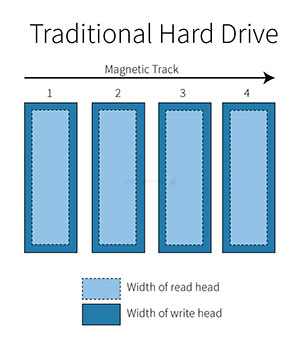
CMR and PMR are effectively different names for the same kind of Drive based Magnetic Recording. A hard drive is made up of numerous circular platters and data is written on to these platters over time. The data is both read to and written from the drive, utilising an internal arm that moves across the disks to apply or retrieve data, with a larger indexing system being managed inside the drive controller and firmware. Data is read and written as and when required on the disc, with data aligning side by side in circles across each platter – hence the word perpendicular in the name. Occasionally, as data is deleted or refreshed on the drive, spaces appear across the platters as the original data was spread throughout the whole drive. This explains the need for occasional defragmentation that cleans up the recorded data to the disk into more manageable and tidy arrangements. Performance is largely dictated by the speed at which these platters rotate for the arm to read and a small area of memory used for live data handling, known as cache. CMR/PMR hard drives have been used consistently in the world of NAS servers for years thanks to the consistent and reliable performance in general access, but also when a RAID storage system requires recovery with a RAID rebuild, resync and re-silvering. Although the general technology and development of NAS hard drives has changed over the last decade (with more tailored architecture and firmware for 24×7 use), the bulk of NAS hard drives are CMR/PMR based.
What are SMR Hard Drives and Should You Use Them in NAS?
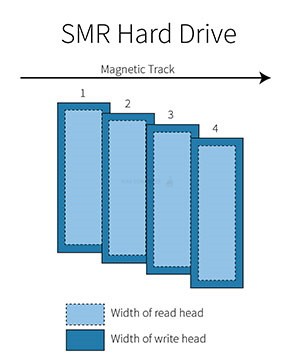
SMR was originally developed as a means of increasing the total available storage on a hard drive. In many ways, the architecture of a SMR drive is identical to that of CMR/PMR, but the big, BIG difference is in how data is written on the platters. The lines that data is written onto located on each platter is fractionally overlapped as write actions take place, much like the shingle tiles on a roof of a building (hence the name) and this allows a larger area of space to be made available on a hard drive compared with perpendicular/conventional write actions. The drive generally needs more cache in order to do this, which in turn can often lead to improved performance on these drives – something that some brands will make a point of highlighting. However, this shingled layout of data is exactly why these drives are less desirable for NAS server use. In most cases, the drive controller will require more time to sort the layout of data on the platters as data is written, often done when the drive is idle. However, when a drive is being constantly accessed, it results in the drive having no time to reorganize the written data as the disc steadily fills. Additionally, in the event of a drive failure, during RAID rebuilding, an SMR Drive will likely take considerably longer to repair on particularly full arrays and often the required idle time for data arrangement is not possible, likely leading to RAID rebuild and RAID resync issues and potentially lost data. This is the main crux of the argument of most people against the use of SMR drives in a NAS server.
Other Hard Drive Types in NAS? What Are HAMR and EAMR Hard Drives?
It is also worth highlighting that in 2020/2021 a couple of new hard drive magnetic recording methods have begun to appear on the market in efforts to achieve even larger storage capacities, while still maintaining performance and reliable storage. Different hard drive brands have approached the subject of using specific area targeted effects on the storage platters in efforts to expand the available area, allowing greater density of storage. Seagate has utilised HAMR, known as heat-assisted magnetic recording. Whereas WD is utilising energy-assisted magnetic recording, or EAMR. Both methods are based on utilising increased temperature in modifying platter write space, as well as taking advantage of helium drive seal technology and for the purposes of this guide, both can be generally considered comparable to PMR/CMR hard drives and not SMR.
Additionally, Seagate is working on drives featuring dual-arm/actuator controlled drives that effectively double read-write performance with their Mac2 series, but these are not quite commercially available yet.
Recommended Hard Drives for NAS?
If you are still wondering about the best Hard Drive to use in your NAS system, as well as wondering the pros and cons of each brand (Speed, Price, Noise, Endurance and more), use the guide below to go through each of the brands and their ranges to see which one is best for you.
Click below to head over to the NAS Hard Drive Help Guide (Will open in a new window)
SMR and CMR/PMR NAS Hard Drives – Which One is Which
The following list of hard drives has been broken into drives that are SMR and drives that are CMR/PMR. Take special note of which drives have suitability for small/big NAS enclosures, as this will make a great deal of difference towards their suitability in larger RAID systems. Remember, Western Digital still include a number of SMR drives in there are WD Red range which is Drive Managed SMR (DM-SMR) and still certifies that these can be utilised in smaller NAS systems. For those that are concerned about their suitability, however, you can still use the WD Red Plus series, which is exclusively CMR/PMR in architecture. Alternatively, the Seagate ironwolf range arrives exclusively in CMR/PMR, with no SMR drives present in their NAS server series.
WD Red (Standard Class) – SMR Hard Drives
Below is the Currently available range of WD Red Hard Drives that arrive in SMR form.
| 1TB WD Red WD10EFRX, 3.5″ NAS HDD, SATA III – 6Gb/s, 5400rpm, 64MB Cache, NCQ,
£56.48
|
3TB WD Red WD30EFRX, 3.5″ NAS HDD, SATA III – 6Gb/s, 5400rpm, 64MB Cache, NCQ,
RRP:£92.99
|
|
| SPECIFICATIONS | ||
|---|---|---|
| Capacity | 1000 GB | 3000 GB |
| Edition | WD Red | WD Red |
| Form Factor | 3.5″ | 3.5″ |
| SSHD | No | No |
| Flash Memory Size | N/A | N/A |
| Flash Memory Type | N/A | N/A |
| Height | 26.1 mm | 26.1 mm |
| Rotation Speed | 5400 rpm | 5400 rpm |
| Sector Size | ||
| Cache | 64MB | 64MB |
| Access Time | N/A | N/A |
| Host to/from Drive Sustained Transfer Rate | 150 MB/s | |
| Interface | SATA 3.0 (6Gb/s) | SATA 3.0 (6Gb/s) |
| Load/Unload Cycles | 600,000 | |
| Annualised Workload Rating | 180 TB/yr | |
| Non-Recoverable Read Errors per Bits Read | <1 in 10^14 | |
| Max. Operating Shock | 30 G | 30 G |
| NCQ | Yes | Yes |
| Max.Power Usage | 3.3 W | |
| Dimensions | 101.6 x 26.1 x 147 (WxHxD mm) | 101.6 x 26.1 x 147 (WxHxD mm) |
| Package Type | OEM | OEM |
WD Red Plus (Standard Class) – CMR/PMR Hard Drives
Below is the Currently available range of WD Red Plus Hard Drives that arrive in CMR & PMR form.
|
2TB WD Red Plus WD20EFZX NAS Hard Drive, 3.5″ HDD, SATA III 6Gb/s, 5400rpm, 128MB Cache, NCQ, £69.98
|
3TB WD Red Plus WD30EFZX NAS Hard Drive, 3.5″ HDD, SATA III 6Gb/s, 5400rpm, 128MB Cache, NCQ, RRP: £95.99
|
4TB WD Red Plus WD40EFZX NAS Hard Drive, 3.5″ HDD, SATA III 6Gb/s, 5400rpm, 128MB Cache, NCQ, £98.48
|
8TB WD Red Plus WD80EFBX NAS Hard Drive, 3.5″ HDD, SATA III 6Gb/s, 7200rpm, 256MB Cache, £207.98
|
10TB WD Red WD101EFAX NAS Hard Drive, 3.5″ HDD, SATA III 6Gb/s, 5400rpm, 256MB Cache, Shock Sensor, NCQ, £263.99
|
10TB WD Red Plus WD101EFBX NAS Hard Drive, 3.5″ HDD, SATA III 6Gb/s, 7200rpm, 256MB Cache, NCQ, £268.99
|
12TB WD Red Plus WD120EFBX NAS Hard Drive, 3.5″ HDD, SATA III 6Gb/s, 7200rpm, 256MB Cache, NCQ, RRP: £324.49
|
|
| SPECIFICATIONS | |||||||
|---|---|---|---|---|---|---|---|
| Capacity | 2000 GB | 3000 GB | 4000 GB | 8000 GB | 10000 GB | 10000 GB | 12000 GB |
| Edition | WD20EFZX | WD30EFZX | WD40EFZX | WD80EFBX | WD Red Plus | WD101EFBX | WD120EFBX |
| Form Factor | 3.5″ | 3.5″ | 3.5″ | 3.5″ | 3.5″ | 3.5″ | 3.5″ |
| SSHD | No | No | No | No | No | No | No |
| Flash Memory Size | N/A | N/A | N/A | N/A | N/A | N/A | N/A |
| Flash Memory Type | N/A | N/A | N/A | N/A | N/A | N/A | N/A |
| Height | 26.1 mm | 26.11 mm | 26.11 mm | 26.11 mm | 26.1 mm | 26.11 mm | 26.11 mm |
| Rotation Speed | 5400 rpm | 5400 rpm | 5400 rpm | 7200 rpm | 5400 rpm | 7200 rpm | 7200 rpm |
| Sector Size | |||||||
| Cache | 128MB | 128MB | 128MB | 256MB | 256MB | 256MB | 256MB |
| Access Time | N/A | N/A | N/A | N/A | N/A | N/A | N/A |
| Host to/from Drive Sustained Transfer Rate | |||||||
| Interface | SATA 3.0 (6Gb/s) | SATA 3.0 (6Gb/s) | SATA 3.0 (6Gb/s) | SATA 3.0 (6Gb/s) | SATA 3.0 (6Gb/s) | SATA 3.0 (6Gb/s) | SATA 3.0 (6Gb/s) |
| Load/Unload Cycles | 600,000 | 600,000 | 600,000 | 600,000 | 600,000 | 600,000 | 600,000 |
| Annualised Workload Rating | 180 TB/yr | 180 TB/yr | 180 TB/yr | 180 TB/yr | 180 TB/yr | 180 TB/yr | 180 TB/yr |
| Non-Recoverable Read Errors per Bits Read | <1 in 10^14 | <1 in 10^14 | <1 in 10^14 | <1 in 10^14 | <1 in 10^14 | <1 in 10^14 | <1 in 10^14 |
| Max. Operating Shock | 70 G | 70 G | 70 G | 65 G | 30 G | 65 G | 65 G |
| NCQ | Yes | Yes | Yes | No | Yes | Yes | Yes |
| Max.Power Usage | 4.8 W | 4.8 W | 4.8 W | 8.4 W | 8.4 W | 8.4 W | 6.5 W |
| Dimensions | 101.6 x 26.1 x 147 (WxHxD mm) | 101.6mm x 26.11mm x 146.99mm (WxHxD mm) | L 146.99mm x W 101.6mm x H 26.11mm (WxHxD mm) | 101.6mm x 26.11mm x 146.99mm (WxHxD mm) | 101.6 x 26.1 x 147 (WxHxD mm) | 101.6 x 26.1 x 147 (WxHxD mm) | 101.6 x 26.1 x 147 (WxHxD mm) |
| Package Type | OEM | OEM | OEM | OEM | OEM | OEM | OEM |
WD Red Pro (Business Class) – CMR/PMR Hard Drives
Below is the Currently available range of WD Red Pro Hard Drives that arrive in CMR & PMR form.
| 12TB WD Red Pro WD121KFBX, 3.5″ NAS HDD, SATA III – 6Gb/s, 7200rpm, 256MB Cache, Shock Sensor, NCQ
£381.98
|
10TB WD Red Pro WD102KFBX NAS Hard Drive, 3.5″ HDD, SATA III 6Gb/s, 7200rpm, 256MB Cache, Shock Sensor, NCQ,
£323.99
|
16TB WD Red PRO WD161KFGX, 3.5″ NAS HDD, SATA III 6Gb/s, 7200rpm, 512MB Cache,
£432.49
|
14TB WD Red Pro WD141KFGX NAS Hard Drive, 3.5″ HDD, SATA III 6Gb/s, 7200rpm, 512MB Cache, NCQ,
£495.98
|
18TB WD Red PRO WD181KFGX, 3.5″ NAS HDD, SATA III 6Gb/s, 7200rpm, 512MB Cache,
£527.99
|
14TB WD Red Plus WD140EFFX NAS Hard Drive, 3.5″ HDD, SATA III 6Gb/s, 5400rpm, 512MB Cache, NCQ, |
|
| Capacity | 12000 GB | 10000 GB | 16000 GB | 14000 GB | 18,000 GB | 14000 GB |
| Edition | WD Red Pro | WD Red Pro | WD161KFGX | Red Pro | WD181KFGX | Red Plus |
| Form Factor | 3.5″ | 3.5″ | 3.5″ | 3.5″ | 3.5″ | 3.5″ |
| SSHD | No | No | No | No | No | No |
| Flash Memory Size | N/A | N/A | N/A | N/A | N/A | N/A |
| Flash Memory Type | N/A | N/A | N/A | N/A | N/A | N/A |
| Height | 26.1 mm | 26.1 mm | 26.1 mm | 26.1 mm | 26.1 mm | 26.1 mm |
| Rotation Speed | 7200 rpm | 7200 rpm | 7200 rpm | 7200 rpm | 7200 rpm | 5400 rpm |
| Sector Size | ||||||
| Cache | 256MB | 256MB | 512MB | 512MB | 512MB | 512MB |
| Access Time | N/A | N/A | N/A | N/A | N/A | N/A |
| Host to/from Drive Sustained Transfer Rate | 240 MB/s | |||||
| Interface | SATA 3.0 (6Gb/s) | SATA 3.0 (6Gb/s) | SATA 3.0 (6Gb/s) | SATA 3.0 (6Gb/s) | SATA 3.0 (6Gb/s) | SATA 3.0 (6Gb/s) |
| Load/Unload Cycles | 600,000 | 600,000 | 600,000 | 600,000 | 600,000 | 600,000 |
| Annualised Workload Rating | 300 TB/yr | 300 TB/yr | 300 TB/yr | 180 TB/yr | 300 TB/yr | 180 TB/yr |
| Non-Recoverable Read Errors per Bits Read | <1 in 10^14 | <1 in 10^14 | <1 in 10^14 | <1 in 10^14 | <1 in 10^14 | <1 in 10^14 |
| Max. Operating Shock | 30 G | 30 G | 50 G | 30 G | 50 G | 30 G |
| NCQ | Yes | Yes | Yes | Yes | Yes | Yes |
| Max.Power Usage | 6.0 W | 8.4 W | 6.1 W | 6.2 W | 6.1 W | 6.5 W |
| Dimensions | 101.6 x 26.1 x 147 (WxHxD mm) | 101.6 x 26.1 x 147 (WxHxD mm) | L 147mm x W 101.6mm x H 26.1mm (WxHxD mm) | 101.6 x 26.1 x 147 (WxHxD mm) | L 147mm x W 101.6mm x H 26.1mm (WxHxD mm) | 101.6 x 26.1 x 147 (WxHxD mm) |
| Package Type | Retail | OEM | OEM | OEM | OEM | OEM |
Seagate Ironwolf (Standard Class) – CMR/PMR Hard Drives
Below is the Currently available range of Seagate Ironwolf NAS Hard Drives that arrive in CMR & PMR form.
|
1TB IronWolf ST1000VN002 NAS Hard Drive, 3.5″ HDD, SATA III 6Gb/s, 5900rpm, 64MB Cache £45.50
|
2TB Seagate ST2000VN004 IronWolf NAS Hard Drive, 3.5″ HDD, SATA III 6Gb/s, 5900rpm, 64MB Cache £70.99
|
3TB Seagate IronWolf ST3000VN007 NAS Hard Drive, 3.5″ HDD, SATA III 6Gb/s, 5900RPM, 64MB Cache £83.99
|
4TB Seagate IronWolf NAS Hard Drive, 3.5″, SATA III – 6GB/s, 5900RPM, 64MB Cache Was:£94.99
|
6TB Seagate IronWolf ST6000VN001 NAS Hard Drive, 3.5″ HDD, SATA III 6Gb/s, 5400rpm, 256MB Cache
£156.99 |
8TB Seagate ST8000VN004 IronWolf NAS Hard Drive, 3.5″ HDD, SATA III 6Gb/s, 7200rpm, 256MB Cache, NCQ £199.99
|
10TB Seagate IronWolf ST10000VN0008 NAS Hard Drive, 3.5″ HDD, SATA III 6Gb/s, 7200rpm, 256MB Cache
£248.48
|
12TB Seagate ST12000VN0008 IronWolf NAS Hard Drive, 3.5″ HDD, SATA III 6Gb/s, 7200rpm, 256MB Cache, NCQ £299.99
|
|
| Capacity | 1000 GB | 2000 GB | 3000 GB | 4000 GB | 6,000 GB | 8000 GB | 10,000 GB | 12000 GB |
| Edition | IronWolf | IronWolf | IronWolf | IronWolf | IronWolf | IronWolf | IronWolf | IronWolf |
| Form Factor | 3.5″ | 3.5″ | 3.5″ | 3.5″ | 3.5″ | 3.5″ | 3.5″ | 3.5″ |
| SSHD | No | No | No | No | No | No | No | No |
| Flash Memory Size | N/A | N/A | N/A | N/A | N/A | N/A | N/A | N/A |
| Flash Memory Type | N/A | N/A | N/A | N/A | N/A | N/A | N/A | N/A |
| Height | 26.1 mm | 26.1 mm | 26.1 mm | 26.1 mm | 26.11 mm | 26.11 mm | 26.11 mm | 26.11 mm |
| Rotation Speed | 5900 rpm | 5900 rpm | 5900 rpm | 5900 rpm | 5,400 rpm | 7200 rpm | 7200 rpm | 7200 rpm |
| Sector Size | 4096N | |||||||
| Cache | 64MB | 64MB | 64MB | 64MB | 256MB | 256MB | 256MB | 256MB |
| Access Time | N/A | N/A | N/A | N/A | 6 ms | N/A | N/A | N/A |
| Host to/from Drive Sustained Transfer Rate | 180 MB/s | 180 MB/s | 180 MB/s | 180 MB/s | 190 MB/s | 210 MB/s | 210 MB/s | 210 MB/s |
| Interface | SATA 3.0 (6Gb/s) | SATA 3.0 (6Gb/s) | SATA 3.0 (6Gb/s) | SATA 3.0 (6Gb/s) | SATA 3.0 (6Gb/s) | SATA 3.0 (6Gb/s) | SATA 3.0 (6Gb/s) | SATA 3.0 (6Gb/s) |
| Load/Unload Cycles | 600,000 | 600,000 | 600,000 | 600,000 | 600,000 | 600,000 | 600,000 | |
| Annualised Workload Rating | 180 TB/yr | 180 TB/yr | 180 TB/yr | 180 TB/yr | <180 TB/yr | 180 TB/yr | 180 TB/yr | 180 TB/yr |
| Non-Recoverable Read Errors per Bits Read | <1 in 10^14 | <1 in 10^14 | <1 in 10^14 | <1 in 10^14 | <1 in 10^14 | <1 in 10^15 | <1 in 10^15 | <1 in 10^15 |
| Max. Operating Shock | 80 G | 80 G | 80 G | 80 G | 70 G | 70 G | 70 G | 70 G |
| NCQ | No | No | No | No | Yes | Yes | No | Yes |
| Max.Power Usage | 5.3 W | 8.8W W | 7.8 W | 7.8 W | ||||
| Dimensions | 101.85 x 20.20 x 146.99 (WxHxD mm) | 101.85 x 26.11 x 146.99 (WxHxD mm) | 101.85 x 26.11 x 146.99 (WxHxD mm) | 101.85 x 26.11 x 146.99 (WxHxD mm) | 101.85 x 26.11 x 146.99 (WxHxD mm) | 101.85 x 26.11 x 146.99 (WxHxD mm) | 101.85 x 26.11 x 146.99 (WxHxD mm) | 101.85 x 26.11 x 146.99 (WxHxD mm) |
Seagate Ironwolf Pro (Business Class) – CMR/PMR Hard Drives
Below is the Currently available range of Seagate Ironwolf Pro NAS Hard Drives that arrive in CMR & PMR form.
| 8TB Seagate IronWolf PRO ST8000NE001 NAS Hard Drive, 3.5″ HDD, SATA III 6Gb/s, 7200rpm, 256MB Cache,
£226.49
|
10TB Seagate IronWolf Pro ST10000NE0008 NAS Hard Drive, 3.5″ HDD, SATA III 6Gb/s, 7200rpm, 256MB Cache, 512E, £275.99
|
12TB Seagate IronWolf Pro ST12000NE0008 NAS Hard Drive, 3.5″ HDD, SATA III 6Gb/s, 7200rpm, 256MB Cache, NCQ, £325.49
|
10TB Seagate ST10000NE0004 IronWolf Pro, 3.5″ NAS HDD, SATA3 6Gb/s, 7200rpm, 256MB, Register for 2yrs FREE Data Recovery
£331.49
|
14TB Seagate IronWolf Pro ST14000NE0008 NAS Hard Drive, 3.5″ HDD, SATA III 6Gb/s, 7200rpm, 256MB Cache, NCQ,
£380.48
|
18TB Seagate ST18000NE000 IronWolf Pro NAS Hard Drive, 3.5″ HDD, SATA III 6Gb/s, 7200rpm, 256MB Cache, £503.99
|
16TB Seagate IronWolf Pro ST16000NE000 NAS Hard Drive, 3.5″ HDD, SATA III 6Gb/s, 7200rpm, 256MB Cache, NCQ, |
|
| Capacity | 8000 GB | 10000 GB | 12000 GB | 10000 GB | 14000 GB | 18000 GB | 16000 GB |
| Edition | IronWolf Pro | IronWolf Pro | IronWolf Pro | IronWolf Pro | IronWolf Pro | Pro | IronWolf Pro |
| Form Factor | 3.5″ | 3.5″ | 3.5″ | 3.5″ | 3.5″ | 3.5″ | 3.5″ |
| SSHD | No | No | No | No | No | No | No |
| Flash Memory Size | N/A | N/A | N/A | N/A | N/A | N/A | N/A |
| Flash Memory Type | N/A | N/A | N/A | N/A | N/A | N/A | N/A |
| Height | 26.11 mm | 26.11 mm | 26.11 mm | N/A | 26.11 mm | 26.11 mm | 26.11 mm |
| Rotation Speed | 7200 rpm | 7200 rpm | 7200 rpm | 7200 rpm | 7200 rpm | 7200 rpm | 7200 rpm |
| Sector Size | 512E/4096N | 512E | 512E/4096N | 512E | 512E | ||
| Cache | 256MB | 256MB | 256MB | 256MB | 256MB | 256MB | 256MB |
| Access Time | 4.16 ms | 4.16 ms | 4.16 ms | 4.16 ms | 4.16 ms | N/A | 4.16 ms |
| Host to/from Drive Sustained Transfer Rate | 238 MB/s | 250 MB/s | 240 MB/s | 260 MB/s | 250 MB/s | ||
| Interface | SATA 3.0 (6Gb/s) | SATA 3.0 (6Gb/s) | SATA 3.0 (6Gb/s) | SATA 3.0 (6Gb/s) | SATA 3.0 (6Gb/s) | SATA 3.0 (6Gb/s) | SATA 3.0 (6Gb/s) |
| Load/Unload Cycles | 600,000 | 600,000 | |||||
| Annualised Workload Rating | 300 TB/yr | 300 TB/yr | 300 TB/yr | 300 TB/yr | 300 TB/yr | 300 TB/yr | |
| Non-Recoverable Read Errors per Bits Read | <1 in 10^15 | <1 in 10^15 | <1 in 10^15 | <1 in 10^15 | <1 in 10^15 | <1 in 10^15 | |
| Max. Operating Shock | 70/40 G | 70 / 40 G | 40 G | 50 G | 50/50 G | 50 G | |
| NCQ | No | Yes | Yes | No | Yes | No | Yes |
| Max.Power Usage | 7.8 W | 7.9 W | 7.9 W | 8 W | 7.6 W | ||
| Dimensions | 101.85 x 26.11 x 146.99 (WxHxD mm) | 101.85 x 26.11 x 147 (WxHxD mm) | 101.85 x 26.11 x 146.99 (WxHxD mm) | 147 x 102 x 26.1 (WxHxD mm) | 101.85 x 26.11 x 146.99 (WxHxD mm) | 101.85 x 26.11 x 146.99 (WxHxD mm) | 101.85 x 26.11 x 146.99 (WxHxD mm) |
| Package Type | OEM | Retail |
Toshiba Hard Drives (Endurance Class) – CMR/PMR Hard Drives
Below is the Currently available range of Toshiba N300 NAS Hard Drives that arrive in CMR & PMR form.
| 4TB Toshiba N300 HDWQ140UZSVA NAS Hard Drive, 3.5″ HDD, SATA III 6Gb/s, 7200rpm, 128MB
£95.99
|
6TB Toshiba N300 HDWN160UZSVA NAS Hard Drive, 3.5″ HDD, SATA III 6Gb/s, 7200rpm, 128MB
£160.49
|
8TB Toshiba N300 HDWG180UZSVA NAS Hard Drive, 3.5″ HDD, SATA III 6Gb/s, 7200rpm, 128MB Cache, 4.17ms,
£167.99
|
10TB Toshiba N300 HDWG11AUZSVA NAS Hard Drive, 3.5″ HDD, SATA III 6Gb/s, 7200rpm, 256MB Cache,
£233.99
|
12TB Toshiba N300 HDWG21CUZSVA NAS Hard Drive, 3.5″ HDD, SATA III 6Gb/s, 7200rpm, 256MB Cache,
£279.98
|
14TB Toshiba N300 NAS HDWG21EUZSVA Hard Drive, 3.5″ HDD, SATA III 6Gb/s, 7200rpm, 256MB
£326.48
|
|
| Manufacturer | Toshiba | Toshiba | Toshiba | Toshiba | Toshiba | Toshiba |
| Capacity | 4000 GB | 6000 GB | 8000 GB | 10,000 GB | 12000 GB | 14000 GB |
| Edition | N300 | N300 | N300 | HDWG11AUZSVA | N300 | N300 |
| Form Factor | 3.5″ | 3.5″ | 3.5″ | 3.5″ | 3.5″ | 3.5″ |
| SSHD | No | No | No | No | No | No |
| Flash Memory Size | N/A | N/A | N/A | N/A | N/A | N/A |
| Flash Memory Type | N/A | N/A | N/A | N/A | N/A | N/A |
| Height | 26.1 mm | 26.1 mm | 26.1 mm | 26.1 mm | 26.1 mm | 26.1 mm |
| Rotation Speed | 7200 rpm | 7200 rpm | 7200 rpm | 7200 rpm | 7200 rpm | 7200 rpm |
| Sector Size | ||||||
| Cache | 128MB | 128MB | 128MB | 256MB | 256MB | 256MB |
| Access Time | 4.17 ms | 4.17 ms | 4.17 ms | N/A | 4.17 ms | 4.17 ms |
| Host to/from Drive Sustained Transfer Rate | 204 MB/s | 241 MB/s | 241 MB/s | 253 MB/s | 260 MB/s | |
| Interface | SATA 3.0 (6Gb/s) | SATA 3.0 (6Gb/s) | SATA 3.0 (6Gb/s) | SATA 3.0 (6Gb/s) | SATA 3.0 (6Gb/s) | SATA 3.0 (6Gb/s) |
| Load/Unload Cycles | ||||||
| Annualised Workload Rating | 180 TB/yr | 180 TB/yr | 180 TB/yr | 180 TB/yr | 180 TB/yr | 180 TB/yr |
| Non-Recoverable Read Errors per Bits Read | <1 in 10^14 | <1 in 10^14 | <1 in 10^14 | <1 in 10^14 | <1 in 10^14 | |
| Max. Operating Shock | 70 G | 70 G | 70G, 2ms duration G | 70 G | 70 G | |
| NCQ | Yes | Yes | Yes | No | Yes | Yes |
| Max.Power Usage | 8.61 W | 9.48 W | ||||
| Dimensions | 101.85 x 26.1 x 147 (WxHxD mm) | 101.85 x 26.1 x 147 (WxHxD mm) | 101.85 x 26.1 x 147 (WxHxD mm) | 101.85 x 26.1 x 147 (WxHxD mm) | 101.85 x 26.1 x 147 (WxHxD mm) | 101.85 x 26.1 x 147 (WxHxD mm) |
Synology Hard Drives (Endurance Class) – CMR/PMR Hard Drives
Below is the Currently available range of Synology HAT5300 NAS Hard Drives that arrive in CMR & PMR form.
| 8TB Synology HAT5300-8T 3.5″ NAS HDD, SATA 6Gb/s, 7200rpm, 256MB Cache, For 24/7 Synology Servers, 5 Year
£257.99
|
12TB Synology HAT5300-12T 3.5″ NAS HDD, SATA 6Gb/s, 7200rpm, 256MB Cache, For 24/7 Synology Servers, 5 Year
£370.49
|
|
| Manufacturer | Synology | Synology |
| Capacity | 8000 GB | 12000 GB |
| Edition | HAT5300-8T | HAT5300-12T |
| Form Factor | 3.5″ | 3.5″ |
| SSHD | No | No |
| Flash Memory Size | N/A | N/A |
| Flash Memory Type | N/A | N/A |
| Height | 26.1 mm | 26.1 mm |
| Rotation Speed | 7200 rpm | 7200 rpm |
| Sector Size | 512E | 512E |
| Cache | 256MB | 256MB |
| Access Time | N/A | N/A |
| Host to/from Drive Sustained Transfer Rate | ||
| Interface | SATA 3.0 (6Gb/s) | SATA 3.0 (6Gb/s) |
| Load/Unload Cycles | ||
| Annualised Workload Rating | 550 TB/yr | 550 TB/yr |
| Non-Recoverable Read Errors per Bits Read | ||
| Max. Operating Shock | 70 G | 70 G |
| NCQ | No | No |
| Max.Power Usage | 9.1 W | 7.83 W |
| Dimensions | 101.85 x 26.1 x 147 (WxHxD mm) | 101.85 x 26.1 x 147 (WxHxD mm) |
Are SMR drives unsuitable for a NAS?
In the short term and in a small NAS array, SMR hard drives are probably ok. You should probably still avoid them where possible, but in less intensive and non-business class use, they should be ok. The key thing to remember is that these drives constantly need time to reposition data internally on the platters and larger arrays, as well as more constant write activity servers, will not play ball in a way that these hard drives can support. The main reason that Western Digital and their WD Red series got in so much trouble was not that they used SMR class drives, it is because they used SMR class drives in their NAS series and did not make this clear enough to buyers.
Western Digital has tried to resolve this problematic PR miss-step with the introduction of the WD Red Plus series to bring a little more clarity to the WD Red portfolio, but for many users this is is still not quite enough contrition from the brand and has likely been quite a humbling instance for them, especially given their market share vs Seagate until recently. In summary, if you are using a 1/2-Bay NAS for private home use (low-level data, media, etc), I think DM=SMR hard drives should be ok. However in almost every other instance, big or small, I will always recommend PMR/CMR hard drive media, due to its more consistent RAID performance and more reliable RAID build, rebuild and resync when the situation requires it.
Learn More About the WD Red HDD DM-SMR Coverage Last Year and Performance Testing Below:
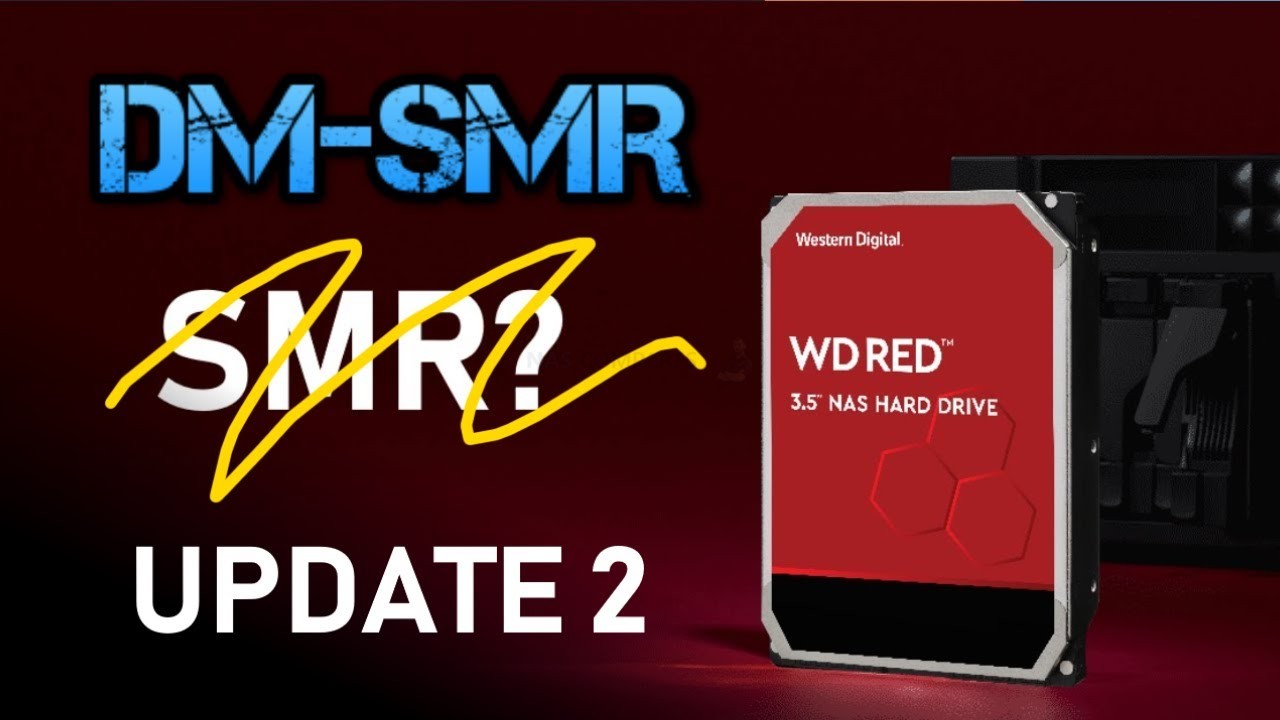 |
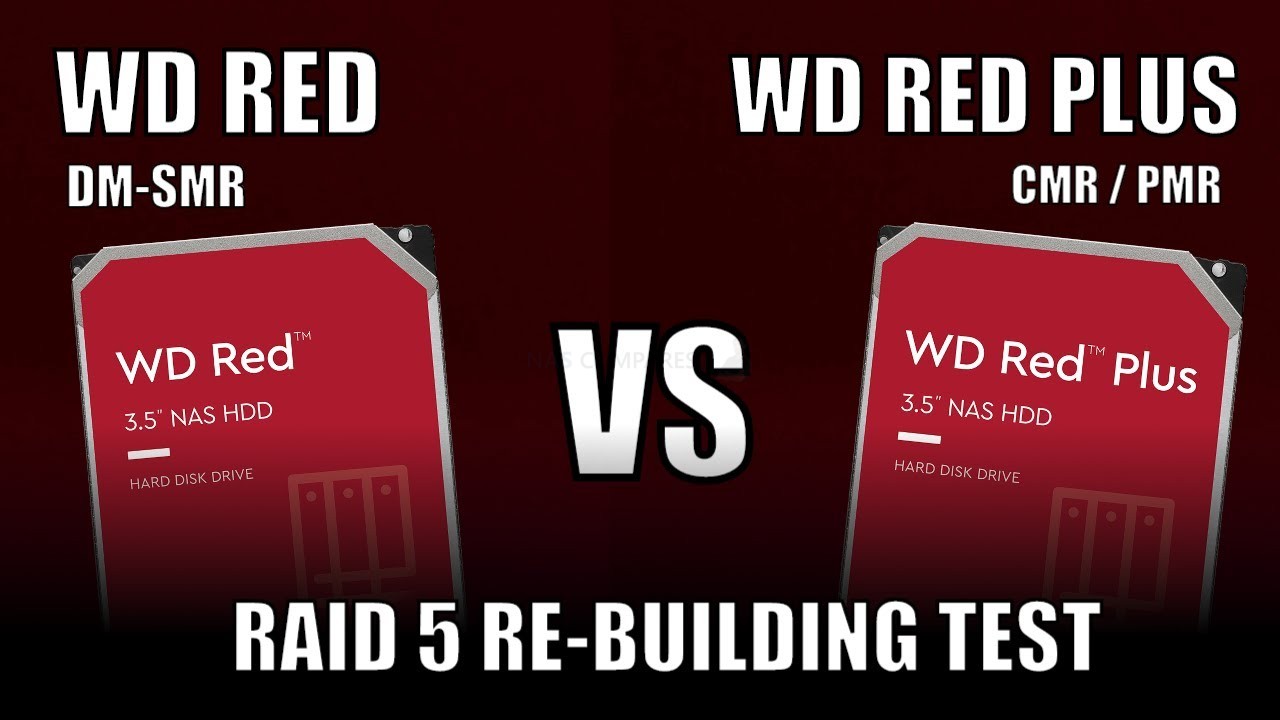 |
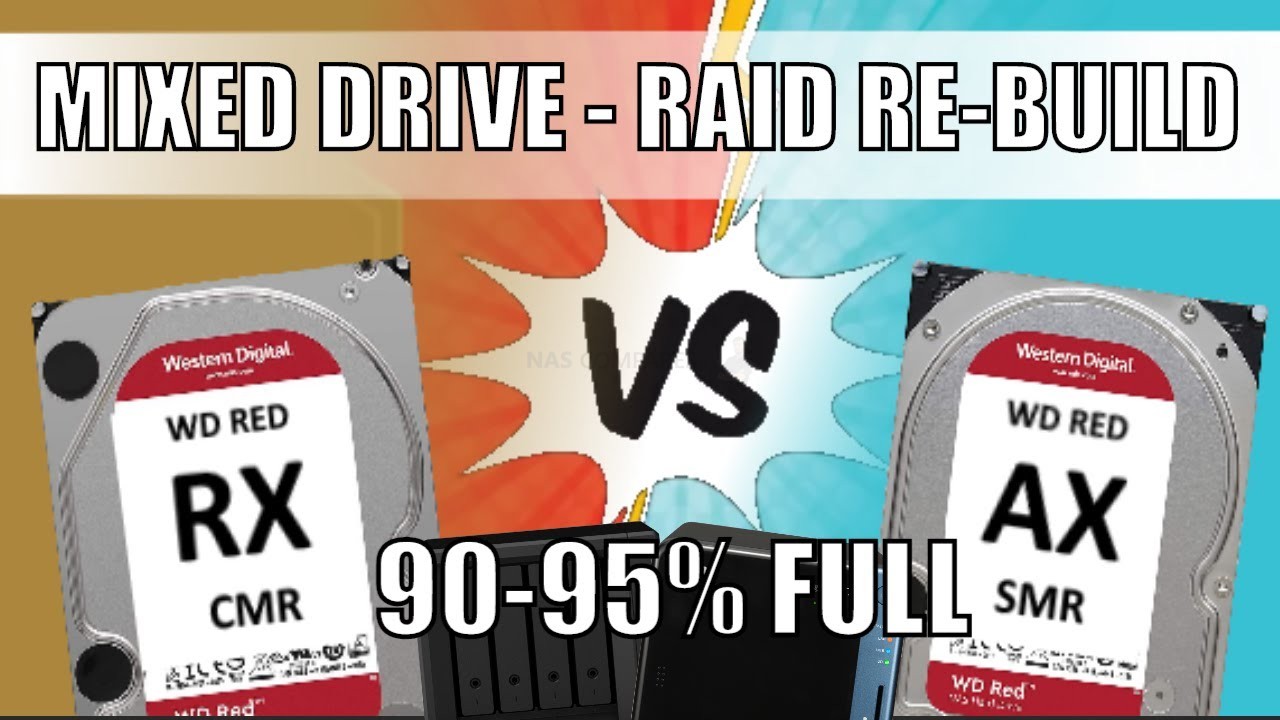 |
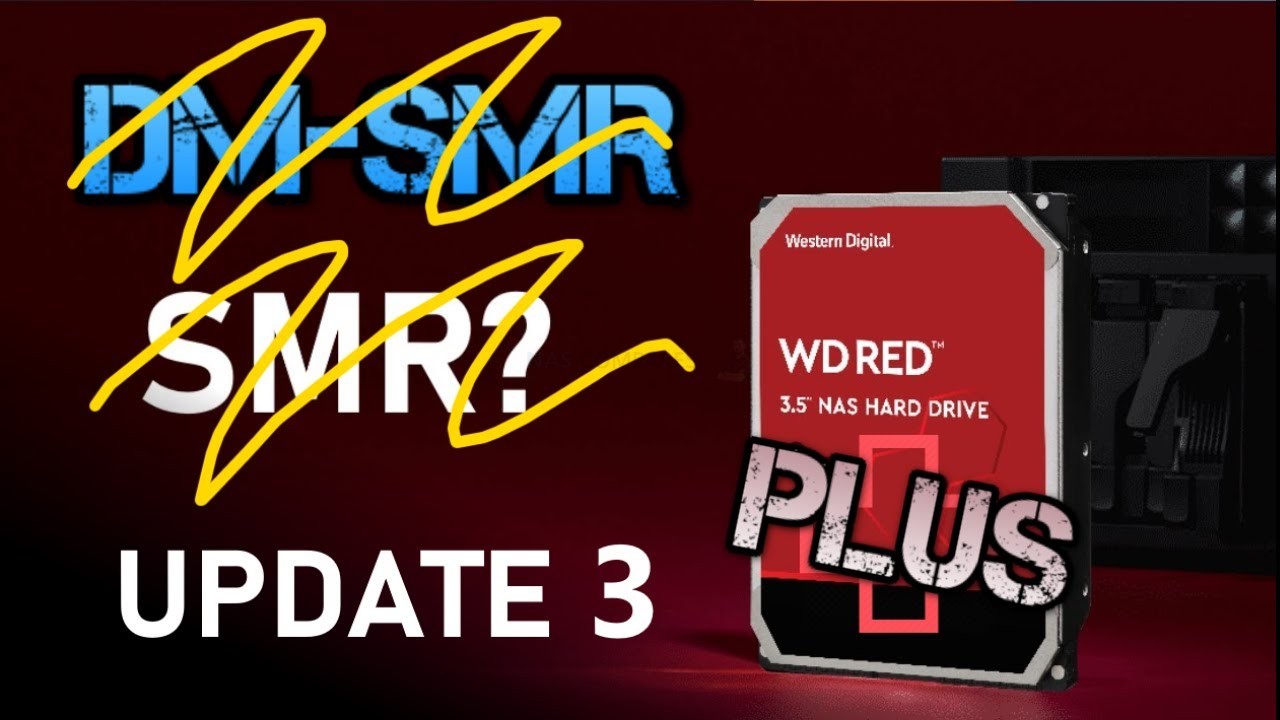 |
📧 SUBSCRIBE TO OUR NEWSLETTER 🔔
🔒 Join Inner Circle
Get an alert every time something gets added to this specific article!
This description contains links to Amazon. These links will take you to some of the products mentioned in today's content. As an Amazon Associate, I earn from qualifying purchases. Visit the NASCompares Deal Finder to find the best place to buy this device in your region, based on Service, Support and Reputation - Just Search for your NAS Drive in the Box Below
Need Advice on Data Storage from an Expert?
Finally, for free advice about your setup, just leave a message in the comments below here at NASCompares.com and we will get back to you. Need Help?
Where possible (and where appropriate) please provide as much information about your requirements, as then I can arrange the best answer and solution to your needs. Do not worry about your e-mail address being required, it will NOT be used in a mailing list and will NOT be used in any way other than to respond to your enquiry.
Need Help?
Where possible (and where appropriate) please provide as much information about your requirements, as then I can arrange the best answer and solution to your needs. Do not worry about your e-mail address being required, it will NOT be used in a mailing list and will NOT be used in any way other than to respond to your enquiry.

|
 |
UGREEN NAS Now has iSCSI, 2FA and Jellyfin (and more) - FINALLY!
Seagate 30TB Ironwolf and EXOS Hard Drive Review
Why Do Cheap NAS Boxes EXIST????
Minisforum N5 Pro NAS - Should You Buy?
UGREEN DH4300 & DH2300 NAS Revealed - Good Value?
Aoostar WTR Max NAS - Should You Buy?
Access content via Patreon or KO-FI







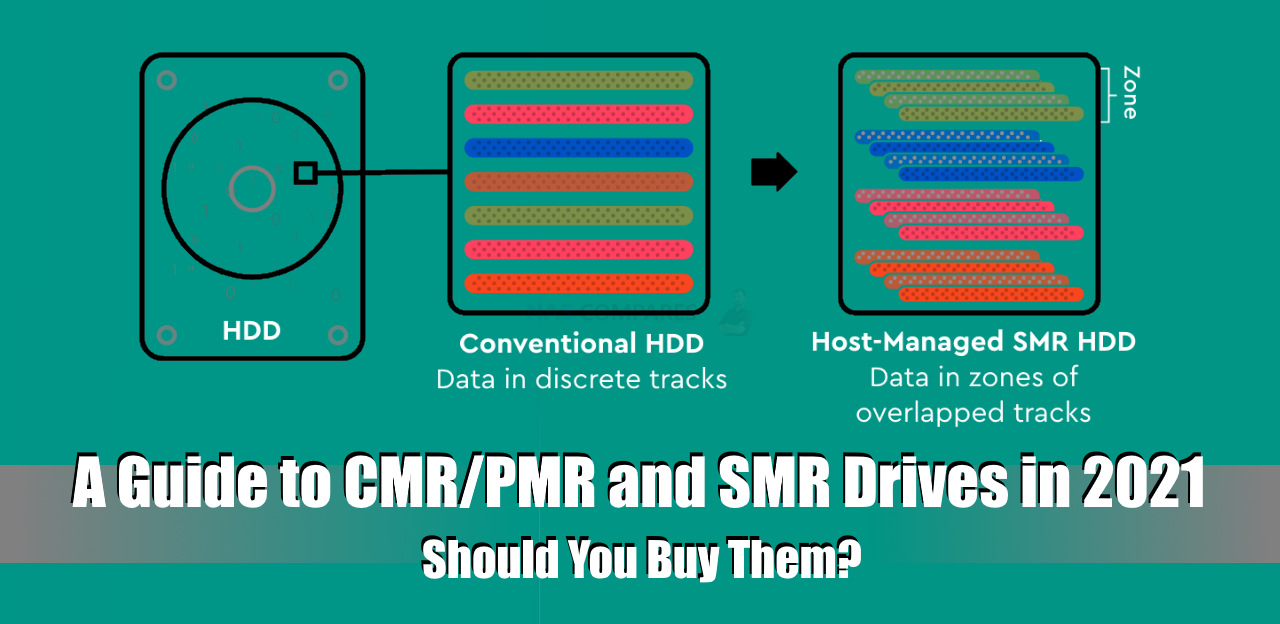





I have WD Red and my DS220J works horribly slow, HDDs grinding all the time and the whole NAS is unusable while they grind ..but how do I know is it mostly because of the weak NAS or because of the bad drives?
REPLY ON YOUTUBE
Old video but I m going to give it a shot. So enterprise sata and sas drives like HGST HUH721212AL5200 that WD states them as PMR are DM-SMR? I don t think so even if in the datasheet only state PMR.
PS I know the presentation here is for WD Reds but found it relevant.
REPLY ON YOUTUBE
Would you recommend a normal new SMR disc or a refurbished one that is CMR both have a 2 year warranty?
Or, for example, for the same price a normal CMR disk of 8tb or a refurbished 12tb for the same price?
REPLY ON YOUTUBE
I never have understood why HDD being as legendary as it is the longest-used storage home use doesn’t have way faster speeds
Like why has it never been models with the rpm of 10k/20/40/50k as standards
Why has the only real upgrade been mostly just bigger in sizes with TB
REPLY ON YOUTUBE
Excelent video! What if raid is buid is with mix drives so one storage pool contain CMR and SMR drives?
REPLY ON YOUTUBE
I have had bad luck with SMR drives. I have lost twice the Raid 1 config and had to rebuilt the NAS twice within 3 years from backup or from extracing the data using 3rd party software.
I used WD Red in 2tb and 6 TB versions. The last 6TB version was SMR. In October it happend that one drive failed. I swapped the drive with a WD Red Puls CMR drive. Now being about 6 weeks further the NAS lost its RAID setting. How? I cannot explain. I don’t know. I believe that it has something to do with the SMR that was still in the second bay. It annoys me that WD did offer SMR drives for NAS even so they are not suitable.
I came across the whole SMR/CMR issue while searching for a NAS to replace my current one which is from 2015.
I will probably go with Synology ds723+ or ds923+
REPLY ON YOUTUBE
so i took out my hdd from my ps4 and reformatted it for my pc and i found out it was a smr hdd :/
REPLY ON YOUTUBE
According to wd website, my red non plus 2x4tb hdd model are cmr, purchased >10 years ago (ex2 nas box). Now still operating (within LAN system, a non supported obsolete product declared in 2022). One hdd has started to have a c5 code error, the other hdd is perfect, just bought a toshiba n300 8tb to mix use as jbod setup. Ex2 is still working.
REPLY ON YOUTUBE
I email WD and asked if the drive was CMR or SMR and they said that no one at western digital knows this information. I call BS on this. SMR has no place near in NAS or RAID.
REPLY ON YOUTUBE
I think Western digital got class action sued over this.
REPLY ON YOUTUBE
you dont anything about computers FOOOOOOOOOOOOOOOOOOL
REPLY ON YOUTUBE
Well…. How did I not know this. I just installed 6 x 6tb WD SMR drives (Rais 5) in my QNAP TS-664-8G NAS , dear God. Mind you I only use it for media storage for Plex so it has allot of idle time but still… Now I just want to cry, it was kind of a big investment lol.
REPLY ON YOUTUBE
It wasn’t even that they weren’t telling anyone, it’s that they kept the same labels and lied about it.
REPLY ON YOUTUBE
They were confusing before and have made it worse. ????
REPLY ON YOUTUBE
OMG i dont care about NAS, I watched this video for normal home use
REPLY ON YOUTUBE
Your audio is soft. Unwatchable. :-/
REPLY ON YOUTUBE
Using something like a NAS in a home environment, I don’t have constant read/write cycles but I want security and longevity.
I think the conventional recording seems more trustworthy.
REPLY ON YOUTUBE
I’d like to compare this to backup tapes. DLT and LTO (linear) never mad a problem whereas technologies squeezing more data into a place like AIT and DAT (helical) were not that reliable. And consequently disappeared from the market.
REPLY ON YOUTUBE
Which RAID config did you have? Sorry but not time to peruse all that video.
REPLY ON YOUTUBE
I hear that the drive has to rewrite the adjacent track when making a change. How does it not end up rewriting the whole disk this way? I think that if the power should fail in the middle of this, there could be more errors. Looks like there is finally a difference between Seagate DM and VX in the recording mode.
I have to flinch every time you touch the disk.
REPLY ON YOUTUBE
What about SMR for PC? I wanted WD RED for PC is it ok? Thanks
REPLY ON YOUTUBE
I’ve now owned a number of WD40EFZX and WD60EFZX HDDs for over a year now, and have had no problems. They are also the quietest HDDs I have ever observed (and I’ve worked with thousands of HDDs). I can barely hear these Red Plus drives even with my ear right next to any of them. Contact vibration is almost non-existant, too. HOWEVER…
Shipment Packaging and Early Failures:
Nwegg packaging of “OEM” HDD offerings is not quite adequate at this time. All drives were packed in bubble-wrap, 1 HDD per small cardboard box. It would have been great packaging EXCEPT…
*one side in EVERY box had an open edge of the bubble-wrap on one side of the HDD*
The HDD could contact the cardboard box sides without any intervening “bubble” along that entire edge. That means on that on one axis the HDDs were NOT properly protected from shock during shipping. Drives also “bounced around” in boxes so that can also expose the drives to high-G shocks during shipping. If dropped on that exposed edge from any reasonable height, the induced shock will exceed the drive’s G-shock spec. That could result in DOAs, early life failures, intermittent errors, or “weird noises” during operation. It’s an easy fix on the shipping prep line and WD should take care of it ASAP.
Negative Reviews and User Error?:
By the way, I also think some number of negative reviews claiming DOA’s, greatly reduced capacity, etc of these drives are due to *_user error_* when first installing and initializing these drives…with users being unfamiliar with GPT v MBR, and OS and hardware incompatibilities with the multi-terabyte drives. I’ve seen compatibility issues between these drives and quite a few docking stations, even when the docking stations claim compatibility.
REPLY ON YOUTUBE
Re statement in video at (02:30)
Probably already covered somewhere in here, but “Plus” also includes 4TB and 6TB drives. WD40EFZX and WD60EFZX
REPLY ON YOUTUBE
This vid suggests that all non-pro reds are SMR. While WD claims only lower and including 6TB ones are? Which is true?
REPLY ON YOUTUBE
Muy buena informacion, aún a dia de hoy 2022 creo que la mejor opcion siguen siendo los CMR, la confiabilidad compensa mucho mas que la capacidad.
REPLY ON YOUTUBE
Are SMR safe for home use, backing up on a daily basis?
REPLY ON YOUTUBE
I have WD Red Plus in a dead Drobo. Can I put them in a Synology NAS directly (with data on them), or am I going to have to reformat them? (I’m probably thinking I have to reformat them, but would love to get your advice).
REPLY ON YOUTUBE
Drive managed SMR if it did it right, would be invisible. But if its noticable/measurable its not doing it well enough.
REPLY ON YOUTUBE
Best way to explain it is you know how DVD DLs work data layers easy as that vs no layers
REPLY ON YOUTUBE
I can’t wait for a 4tb SSD to cost around €100…
REPLY ON YOUTUBE
If hdd has more than 64MB cache, like 256MB, then it’s most likely SMR, as memory is needed for such use.
REPLY ON YOUTUBE
so for one drive gaming machine smr drives are completely ok?
REPLY ON YOUTUBE
Telling the truth by putting CMR or SMR is too confusing. Better to keep it a secret and drawing in the suckers then selling them a pile of shit. Just like a Venus fly trap does to a fly.
REPLY ON YOUTUBE
WD160EDGZ-11B2DA0 in my WD Elements 16TB. It is not on your list on your website. Is this CMR or SMR shingled???
REPLY ON YOUTUBE
Hey there! Thanks a lot for awesome explaination. Well I’m a freelance videographer and can’t afford to go with Premium Red series drives. Currently! I’ve 02 SMR External HDDs from WD & Transcend I use 1 for main & other for backup. I copy data from my Memory card into these boths. The Data is usually 100+ GB per day shoot. Then I keep these hard drives in storage until I’ve to edit footage then I just copy data from one of these to my SSD and then perform Edits using my SSD. Am I safe for now? AS my HD drives are usually under pressure for few minutes per week and then they rest in my drawer. Waiting for your response.
REPLY ON YOUTUBE
Awesome explanation! TY!
REPLY ON YOUTUBE
no no no
we need McNeil…tests
REPLY ON YOUTUBE
SMR = CRAP (Avoid it if you can)
PMR = CMR
np 🙂
REPLY ON YOUTUBE
still pretty confused… the WD Red plus in 2 to 6GB are in red color in the table, are they no good?
REPLY ON YOUTUBE
Come ooon, the 2x14s were supposed to launch in June for 500USD
REPLY ON YOUTUBE
Hi. What about using an SMR drive for storing videos and photos in a PC? I specifically asked the online seller if it’s a specific WD model (WD40EZRZ .. this is CMR) and they said yes, but when it arrived it’s an SMR (WD40EZAZ). I already talked to the seller and they apologized for sending the wrong item and are willing to replace it (though they need to check their inventory first) but the return procedure is just a bit of a hassle given my particular situation. Should I just suck it up and accept this SMR drive or should I really return it?
REPLY ON YOUTUBE